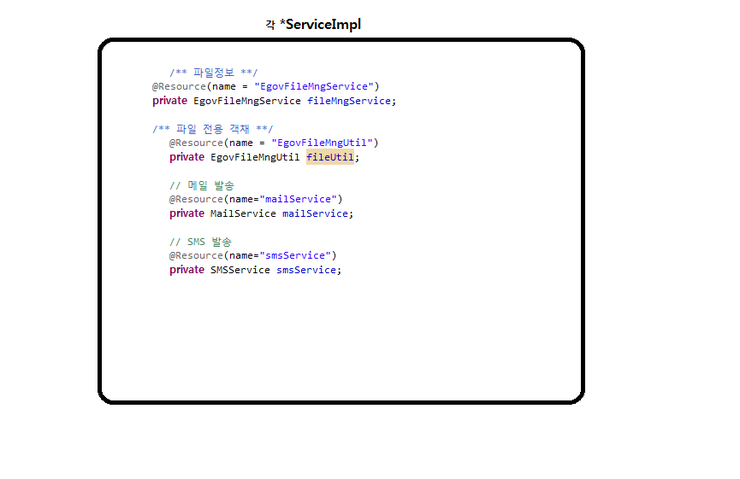티스토리 뷰
1. 서비스 Impl에 대한 고민
요근래 프로젝트를 하다보면서 느낀점이지만
자주쓰이는 component 들을 매번 Service단에 선언하는 것들이 많이 있었습니다.
(DI 주입 관련)
@Resource(name="메일서비스")
@Resource(name="sms발송 서비스")
@Resource(name="파일관련")
등등 이 있었는데
매번 클래스에 정의해 두고 했었습니다.
그런데 차라리 저렇게 선언할꺼면 따로 클래스에 protected로 정의해놓고
extends 받아서 사용하면 어떨까 생각이 문득 들었습니다.
(물론 매번 컨씨 컨브이로 붙이긴 하지만 그런 귀차니즘 해소용으로도..)
이렇게 작성하게 되면 오히려 개발할때 좀더 개발자를 어렵게(?) 하거나,
파일 관련 부분만 사용하는건데 메일이나 sms발송 쪽도 같이 따라오기 때문에
성능상 문제가 있는지 궁금하네요.
개념도는 아래와 같습니다.


ex) 소스 코드 예
컴포넌트 클래스 (가정)
1 2 3 4 5 6 7 8 9 10 11 12 13 14 15 16 17 18 19 20 21 22 23 24 25 26 27 28 29 30 31 32 33 34 35 | package mngwserc.com.customer.service; import javax.annotation.Resource; import egovframework.com.cmm.service.EgovFileMngService; import egovframework.com.cmm.service.EgovFileMngUtil; import egovframework.com.cmm.service.MailService; import egovframework.com.cmm.service.SMSService; import egovframework.com.cmm.service.impl.FileManageDAO; public class CommonService { /** 파일정보 **/ @Resource(name = "EgovFileMngService") protected EgovFileMngService fileMngService; /** 파일 전용 객채 **/ @Resource(name = "EgovFileMngUtil") protected EgovFileMngUtil fileUtil; // 파일 DAO 선언 @Resource(name="FileManageDAO") protected FileManageDAO fileDAO; // 메일 발송 @Resource(name="mailService") protected MailService mailService; // SMS 발송 @Resource(name="smsService") protected SMSService smsService; } |
상속받는 serviceImpl 클래스
1 2 3 4 5 6 7 8 9 10 11 12 13 14 15 16 17 18 19 20 21 22 23 24 25 26 27 28 29 30 31 32 33 34 35 36 37 38 39 40 41 42 43 44 45 46 47 48 49 50 51 | @Service("unsuitableService") public class UnsuitableServiceImpl extends CommonService implements UnsuitableService { // DAO 선언 @Resource(name="unsuitableDAO") private UnsuitableDAO dao; // INDEX값 선언 @Resource(name="UnsuitableIdgen") private EgovIdGnrService IDX; public void insertUnsuitableInfo(Map<String, MultipartFile> files, UnsuitableVO vo) throws Exception{ try{ if(!files.isEmpty()){ List<FileVO> atchFileId = null; String attach_file_id = null; int limitFileSize = Integer.parseInt(EgovProperties.getProperty("Globals.atchfileSize")); atchFileId = fileUtil.parseFileInf(files, "", 0, "", "Globals.fileStorePath", limitFileSize); // 파일 아이디 if(atchFileId.size() > 0) { attach_file_id = fileMngService.insertFileInfs(atchFileId); } if(files.size() != atchFileId.size()){ throw new MaxUploadSizeExceededException(10485760); } if(attach_file_id != null){ vo.setATCH_FILE_ID(attach_file_id); } } // 첨부 파일 끝 vo.setIDX(IDX.getNextIntegerId()); // PK 값 셋팅 dao.insertUnsuitableInfo(vo); // 정보 입력 }catch(MaxUploadSizeExceededException me){ System.out.println(me.getMessage()); throw new MaxUploadSizeExceededException(10485760); } catch(Exception e){ e.printStackTrace(); throw new UnknownErrorException(" Error"); } } |
위와 같이 하는 것 입니다.
2. 컨트롤러 -> 서비스 간 고민
기존 프로젝트 진행중 Controller 와 ServiceImpl 간 경계가 좀 모호했었습니다.
예를 들자면
1 2 3 4 5 6 7 8 9 10 11 12 13 14 15 16 17 18 19 20 21 22 23 24 25 26 27 28 29 30 31 32 33 34 35 36 37 38 39 40 41 42 43 44 45 46 47 48 49 50 51 52 53 54 55 56 57 58 59 60 61 62 63 64 65 66 67 68 69 70 71 72 73 74 75 76 | @RequestMapping(value = "/mngwserc/customer/clientIdea/put.do", method = RequestMethod.POST) public String insertClientIdea(final MultipartHttpServletRequest multiRequest, ModelMap modelMap, @Valid @ModelAttribute("clientIdea") ClientIdeaVO clientIdeaVO, BindingResult biresult) throws Exception { String url = ""; if (biresult.hasErrors()) { System.out.println("BindingResult ERROR : "+ multiRequest.getRequestURI()); modelMap.addAttribute("commandName", clientIdeaVO); return "error/error.error"; } try { HttpSession session = multiRequest.getSession(false); if (session != null) { LoginVO loginVO = (LoginVO) session.getAttribute("loginVO"); clientIdeaVO.setIDEAIDX(idgnService.getNextIntegerId()); clientIdeaVO.setREGID(loginVO.getId()); clientIdeaVO.setREGNAME(loginVO.getName()); clientIdeaVO.setREGIP(multiRequest.getRemoteAddr()); clientIdeaVO.setPROCESS_RESULT("A"); // 첨부파일 업로드 final Map<String, MultipartFile> files = multiRequest.getFileMap(); if (!files.isEmpty()) { List<FileVO> atchFileId = null; String atch_file_id = null; atchFileId = fileUtil.parseFileInf(files, "", 0, "", "Globals.fileStorePath", Integer.parseInt(FileSize)); if (atchFileId.size() > 0) { atch_file_id = fileMngService.insertFileInfs(atchFileId); } if (files.size() != atchFileId.size()) { throw new MaxUploadSizeExceededException(10485760); } if (atch_file_id != null) { // ATTACH_FILE_ID 삽입 clientIdeaVO.setATCH_FILE_ID(atch_file_id); } } service.insertClientIdea(clientIdeaVO); } } catch (MaxUploadSizeExceededException me) { System.out.println(me.getMessage()); throw new MaxUploadSizeExceededException(10485760); } catch (Exception e) { e.printStackTrace(); throw new UnknownErrorException("Error!!"); } url = "redirect:/mngwserc/customer/clientIdea/list.do"; return url; } |
위와 같이 컨트롤러 단에 file업로드 처리를 하는가 하면, serviceImpl 쪽에서 처리하는 그런 것 내용도 있었습니다.
따라서 생각해보았는데요.
Controller 단에서 MultipartRequest 로 넘어오면 multirequest 객체 안에 getFileMap(); 함수를 이용해서 얻은
파일 정보들만 service 단으로 넘겨주는 겁니다.
기본적인 필요한 정보(parameter) 들은 VO에 저장되기 때문에 파일 정보만 따로 빼서 넣으면 될 것 같습니다.
1 2 3 4 5 6 7 8 9 10 11 12 13 14 15 16 17 18 19 20 21 22 23 24 25 26 27 | @RequestMapping(value="/mngwserc/customer/unsuitable/insert.do") public String insertUnsuitableInfo(final MultipartHttpServletRequest multiRequest, ModelMap modepMap, @ModelAttribute("UnsuitableVO") UnsuitableVO vo, BindingResult biresult, ModelMap modelMap) throws Exception{ // 유효성 체크 if(biresult.hasErrors()) { modelMap.addAttribute("commandName", vo); return "error/validerror.error"; } // 작성 (내용 입력) HttpSession session = multiRequest.getSession(false); if(session != null){ LoginVO user = (LoginVO)session.getAttribute("loginVO"); vo.setREGIP(user.getIp()); vo.setREGNAME(user.getName()); vo.setREGID(user.getId()); } final Map<String, MultipartFile> files = multiRequest.getFileMap(); service.insertUnsuitableInfo(files, vo); return "ㅁㅣㄱㅗㅇㄱㅐ"; } |
서비스 impl 단에서는 아래와 같이 사용합니다.
1 2 3 4 5 6 7 8 9 10 11 12 13 14 15 16 17 18 19 20 21 22 23 24 25 26 27 28 29 30 31 32 33 34 35 36 37 38 39 | public void insertUnsuitableInfo(Map<String, MultipartFile> files, UnsuitableVO vo) throws Exception{ try{ if(!files.isEmpty()){ List<FileVO> atchFileId = null; String attach_file_id = null; int limitFileSize = Integer.parseInt(EgovProperties.getProperty("Globals.atchfileSize")); atchFileId = fileUtil.parseFileInf(files, "", 0, "", "Globals.fileStorePath", limitFileSize); // 파일 아이디 if(atchFileId.size() > 0) { attach_file_id = fileMngService.insertFileInfs(atchFileId); } if(files.size() != atchFileId.size()){ throw new MaxUploadSizeExceededException(10485760); } if(attach_file_id != null){ vo.setATCH_FILE_ID(attach_file_id); } } // 첨부 파일 끝 vo.setIDX(IDX.getNextIntegerId()); // PK 값 셋팅 dao.insertUnsuitableInfo(vo); // 정보 입력 }catch(MaxUploadSizeExceededException me){ System.out.println(me.getMessage()); throw new MaxUploadSizeExceededException(10485760); } catch(Exception e){ e.printStackTrace(); throw new UnknownErrorException(" Error"); } } |
위와 같이 하면 컨트롤러단에서 비즈니스 로직처리 부분이 빠지고 깔끔하게 진행되고
또한 현재 프레임워크에서 serviceImpl에 transaction을 걸어 놓은 상태이기 때문에 service단에서 에러가 발생하면
db insert된 정보가 롤백되고, 또한 트렌젝션을 어디다가 걸지 고민하지 않고 클래스명에 serviceImpl 로 끝나는 메소드마다 걸어주면 되니
관리 또한 편할 것 같습니다.
3. 프로퍼티 관련 고민.
현재 전자정부프레임워크 내에 fileMngUtil.java를 살펴보던 도중에 Globals 라는 클래스를 사용하는걸 보게되었습니다.
1 2 3 4 5 6 7 8 9 10 11 12 13 14 15 16 17 18 19 20 21 22 23 24 25 26 27 28 29 30 31 32 33 | /** * 첨부로 등록된 파일을 서버에 업로드한다. * * @param file * @return * @throws Exception */ public static HashMap<String, String> uploadFile(MultipartFile file) throws Exception { HashMap<String, String> map = new HashMap<String, String>(); //Write File 이후 Move File???? String newName = ""; String stordFilePath = EgovProperties.getProperty("Globals.fileStorePath"); String orginFileName = file.getOriginalFilename(); int index = orginFileName.lastIndexOf("."); //String fileName = orginFileName.substring(0, _index); String fileExt = orginFileName.substring(index + 1); long size = file.getSize(); //newName 은 Naming Convention에 의해서 생성 newName = getTimeStamp(); // 2012.11 KISA 보안조치 writeFile(file, newName, stordFilePath); //storedFilePath는 지정 map.put(Globals.ORIGIN_FILE_NM, orginFileName); map.put(Globals.UPLOAD_FILE_NM, newName); map.put(Globals.FILE_EXT, fileExt); map.put(Globals.FILE_PATH, stordFilePath); map.put(Globals.FILE_SIZE, String.valueOf(size)); return map; } |
저게 뭔가해서 안을 열어보니 globals.property에 선언한 공통으로 쓰여질 값들을 static 변수로 담아놓고 사용하는 것을 확인 했습니다.
1 2 3 4 5 6 7 8 9 10 11 12 13 14 15 16 17 18 19 20 21 22 23 24 25 26 27 28 29 30 31 32 33 34 35 36 37 38 39 40 41 | public class Globals { //OS 유형 public static final String OS_TYPE = EgovProperties.getProperty("Globals.OsType"); //DB 유형 public static final String DB_TYPE = EgovProperties.getProperty("Globals.DbType"); //메인 페이지 public static final String MAIN_PAGE = EgovProperties.getProperty("Globals.MainPage"); //ShellFile 경로 public static final String SHELL_FILE_PATH = EgovProperties.getPathProperty("Globals.ShellFilePath"); //퍼로퍼티 파일 위치 public static final String CONF_PATH = EgovProperties.getPathProperty("Globals.ConfPath"); //Server정보 프로퍼티 위치 public static final String SERVER_CONF_PATH = EgovProperties.getPathProperty("Globals.ServerConfPath"); //Client정보 프로퍼티 위치 public static final String CLIENT_CONF_PATH = EgovProperties.getPathProperty("Globals.ClientConfPath"); //파일포맷 정보 프로퍼티 위치 public static final String FILE_FORMAT_PATH = EgovProperties.getPathProperty("Globals.atchFileExt"); //파일 업로드 원 파일명 public static final String ORIGIN_FILE_NM = "originalFileName"; //파일 확장자 public static final String FILE_EXT = "fileExtension"; //파일크기 public static final String FILE_SIZE = "fileSize"; //업로드된 파일명 public static final String UPLOAD_FILE_NM = "uploadFileName"; //파일경로 public static final String FILE_PATH = "filePath"; //메일발송요청 XML파일경로 public static final String MAIL_REQUEST_PATH = EgovProperties.getPathProperty("Globals.MailRequestPath"); //메일발송응답 XML파일경로 public static final String MAIL_RESPONSE_PATH = EgovProperties.getPathProperty("Globals.MailRResponsePath"); // G4C 연결용 IP (localhost) public static final String LOCAL_IP = EgovProperties.getProperty("Globals.LocalIp"); } |
따라서 저희가 자주 사용하는 파일 경로라던지 메일 경로들을 저 클래스 안에 추가적으로 선언하고
사용하면 좋지 않을까 하는 생각이 들어서
앞으로 프로젝트 진행시에 한번 이용해봤으면 했습니다.
'Web Development > 전자정부프레임워크' 카테고리의 다른 글
| 타일즈 (Tiles ) 셋팅 (1) | 2015.01.10 |
|---|
- Total
- Today
- Yesterday
- jstl foreach
- java 특정문자 갯수구하기
- java 설치
- java 폴더구조 구하기
- JSP 세션
- java calendar
- POI EXCEL
- spring ExcelView
- JSTL
- coroutine
- jstl 커스텀 태그
- java 설정
- spring property
- Database#transaction
- Kotlin
- java 압축 풀기
- POE Excel 만들기
- 코루틴
- 전자정부프레임워크 tiles
- github image 첨부시 주의할점
- mybatis Merge
- jstl split
- MyBatis 팁
| 일 | 월 | 화 | 수 | 목 | 금 | 토 |
|---|---|---|---|---|---|---|
| 1 | 2 | 3 | 4 | 5 | ||
| 6 | 7 | 8 | 9 | 10 | 11 | 12 |
| 13 | 14 | 15 | 16 | 17 | 18 | 19 |
| 20 | 21 | 22 | 23 | 24 | 25 | 26 |
| 27 | 28 | 29 | 30 |
